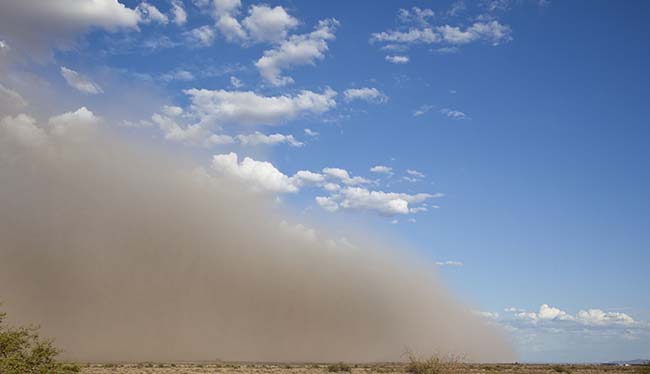Updated guidelines for treating people infected with Valley Fever, a disease caused by a fungus that is common in the U.S. Southwest, have been produced by a panel of experts led by John N. Galgiani, MD, director of the Valley Fever Center for Excellence at the University of Arizona Health Sciences.
The recommendations include suggested treatment options for pregnant women, patients who are immunocompromised and others who may have a higher risk of severe illness. In severe cases, the disease may spread from the lungs to the bones or the brain.
Dr. Galgiani, a UA professor of medicine, is the lead author of the “2016 Infectious Diseases Society of America (IDSA) Clinical Practice Guidelines for the Treatment of Coccidioidomycosis,” geared toward primary care physicians and recently published in the journal, Clinical Infectious Diseases.
Fungal Illness Endemic to Southwest
Coccidioidomycosis, or Valley Fever, is caused by the Coccidioides fungus. Found in soils of the U.S. Southwest, it causes infection when inhaled that often is mistaken as bacterial or viral pneumonia, resulting in unnecessary tests and inappropriate therapy.
The guidelines suggest shorter courses of antibiotics for hospitalized patients and more ambulatory treatment for most individuals who have contracted Valley Fever. Galgiani noted a friend diagnosed with Valley Fever spent several days in the hospital and should not have been admitted, as care for the fungal disease often can be managed in an outpatient clinic setting at much less expense.
“That’s an example of $20,000 of hospital care, maybe $30,000, that was unnecessary for best care,” Dr. Galgiani said. “The new guidelines are intended to address that.”
Dr. Galgiani notes, of all U.S. Valley Fever infections (about 150,000 per year), two-thirds are contracted in Arizona. Most people recover in a matter of weeks or months, but about 160 patients die each year from the disease.
Animals, especially dogs, also are susceptible. A sea lion at a zoo in Fresno, Calif., reportedly died of Valley Fever in July and an African lion died of the disease last October at Tucson’s Reid Park Zoo.
In updating the guidelines, Dr. Galgiani led a panel of 16 experts—including fellow UA College of Medicine – Tucson physicians Neil M. Ampel, MD, and Jeffrey R. Lisse, MD—who reviewed available literature on coccidioidomycosis. The panel’s recommendations update IDSA guidance from 2005, when Dr. Galgiani also was the lead author. Dr. Ampel is UA professor of medicine in the Division of Infectious Diseases, a member of the Valley Fever Center for Excellence and an infectious diseases specialist at the Southern Arizona VA Healthcare System. Dr. Lisse recently retired as UA professor in the Division of Rheumatology and has joined Eli Lilly & Co.
Working to Protect People and Pets
At the UA Valley Fever Center for Excellence, researchers are working on a vaccine for humans as well as for pets, in addition to improved rapid detection methodologies and treatment therapies for the disease.
For patients, Dr. Galgiani runs a Valley Fever Clinic at Banner – University Medical Center Tucson.
The UA Valley Fever Center for Excellence and Banner – UMC hospitals in Tucson and Phoenix are participating in clinical trials that began earlier this year related to a National Institutes of Health-funded study for which Duke University’s Human Vaccine Institute was awarded $5 million to support research into Valley Fever pneumonia. That funding could grow to $9 million if all contract options are exercised. Principal investigators in a $2-million subcontract for Arizona are Dr. Galgiani and Ken Knox, MD, UA professor of medicine and immunobiology, chief of the Division of Pulmonary, Allergy, Critical Care and Sleep Medicine and the Murray and Clara Walker Memorial Endowed Chair in Emphysema.
The UA Valley Fever Center for Excellence also promotes various community information and health-care professional programs across Arizona during Valley Fever Awareness Week, which this year will be Nov. 12-20. Events include the Annual Farness Lecture at the UA College of Medicine – Tucson that will be held Wednesday, Nov. 16, with invited speaker Janis E. Blair, MD, chair of the Division of Infectious Diseases, Mayo Clinic, Phoenix, whose research includes Valley Fever.
A reference booklet, “Valley Fever (Coccidoidomycosis)—Tutorial for Primary Care Physicians,” that includes facts physicians and other health-care professionals need about Valley Fever, including how to diagnose it and what to do when a new infection is discovered, has been produced by the UA Valley Fever Center for Excellence and is available through the medical societies of Pima and Maricopa Counties, Arizona Medical Association, Arizona Department of Health Services and U.S. Centers for Disease Control and Prevention. An electronic copy of the booklet—as well as the new IDSA Guidelines—also is posted on the UA Valley Fever Center for Excellence website under the “Clinicians” tab at www.vfce.arizona.edu




